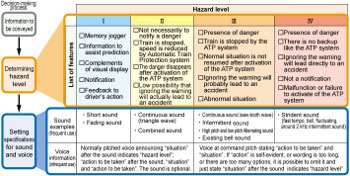12. Process to select appropriate sounds to convey in-cab driver alerts
A rise in recent years in the type and variety of driving assistance and safe-guard technologies, a growing number of sounds emitted inside driving cabs, and an increasing variety of tones used for warning devices has raised the concern that this may distract or affect the concentration of drivers, and therefore work has begun on developing a design guideline to unify sound alerts.
A chart has been proposed for designers to help choose sounds when adding any new sound alerts.
The importance of the information to be conveyed was split into four categories (hazard level) according to likelihood of an accident, and selection criteria were devised for each category (Table 1).
The chart contains example sounds and voice messages for each hazard level based on the degree of urgency they made drivers perceive.
A checklist is proposed to guide the selection between sound and voice, based mainly on frequency of use, characteristics of the sound which could be confused with existing alerts, and to limit number of the sounds to an acceptable level, etc.
Methods for determining sounds according to urgency of the warning already exist in the automobile and aviation sector. However, the railway environment is very different, given the type of information, the complexity of required responses, the supposed sound environment and the existing visual and audio information burden.
Consequently, based on interviews with those responsible for system design, and tests and surveys with on-board staff, a classification and voice-notification method suited to railways has been proposed.
By adopting a uniform approach to in-cab information drivers will be able to instinctively perceive hazard levels, while it would also reduce the possibility of selecting easily confused sounds and allow clear delivery of the intended message to drivers.
Other Contents
- 1. Seismic ground motion simulator applicable to M9 earthquakes
- 2. Seismic Hazard simulator for railways
- 3. Early warning system employing ocean bottom seismometer data
- 4. Development of Railway Embankment Structures Resistant to severe Earthquakes and Prolonged Overflows caused by Tsunamis
- 5. Measures against buckling of ballasted track during earthquakes
- 6. Disaster Hazard Mapping Technology
- 7. Method for diagnosing condition of concrete roadbed in tunnels
- 8. Analytical method for evaluating carbody safety aimed at reducing passenger injury in case of level crossing collisions
- 9. Bogie to control decrement in wheel load
- 10. Mechanical pneumatic steering system with failsafe function
- 11. Gear oil for Shinkansen trains with improved startability in low temperature conditions
- 12. Process to select appropriate sounds to convey in-cab driver alerts
- 13. Training in communication techniques for train dispatchers in disrupted situations
- 1. Seismic ground motion simulator applicable to M9 earthquakes
- 2. Seismic Hazard simulator for railways
- 3. Early warning system employing ocean bottom seismometer data
- 4. Development of Railway Embankment Structures Resistant to severe Earthquakes and Prolonged Overflows caused by Tsunamis
- 5. Measures against buckling of ballasted track during earthquakes
- 6. Disaster Hazard Mapping Technology
- 7. Method for diagnosing condition of concrete roadbed in tunnels
- 8. Analytical method for evaluating carbody safety aimed at reducing passenger injury in case of level crossing collisions
- 9. Bogie to control decrement in wheel load
- 10. Mechanical pneumatic steering system with failsafe function
- 11. Gear oil for Shinkansen trains with improved startability in low temperature conditions
- 12. Process to select appropriate sounds to convey in-cab driver alerts
- 13. Training in communication techniques for train dispatchers in disrupted situations

